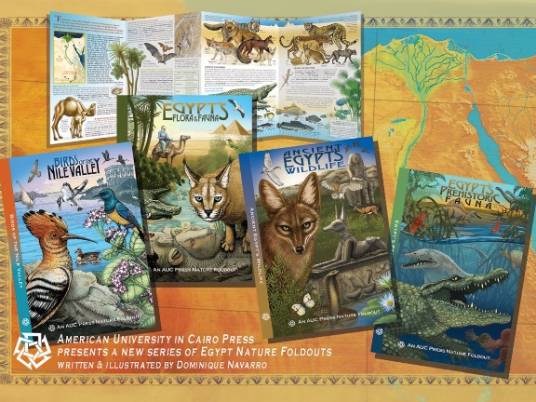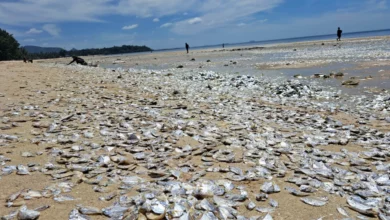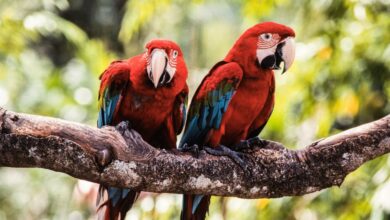
To illustrate and provide scientific information about Egypt’s rich biodiversity and animals, the American University in Cairo Press recently published a series of nature foldouts.
The foldouts, titled “Egypt’s Flora and Fauna,” “Birds of the Nile Valley,” “Ancient Egypt’s Wildlife” and “Egypt’s Prehistoric Fauna,” are written and illustrated by California-based writer and artist Dominique Navarro, who focuses on natural history and is a trained forensic artist. They provide a non-exhaustive but nonetheless fascinating account of the myriad plant and animal species that make Egypt a cradle of biodiversity.
During a two-month excavation of a temple tomb near Luxor in 2011, Navarro began to marvel at the ancient Egyptians’ attachment and reverence to the animals and plants that constituted their direct environment. After digging up hieroglyphic fragments and discovering depictions of birds and animals drawn by ancient artists, and becoming immersed in Upper Egypt’s tantalizing Nile River’s ecosystem, the artist got the idea to start working on the foldouts.
She explains that she was inspired by the way ancient Egyptians found their environment so invaluable that they depicted it in all aspects of their culture, from the architecture to the hieroglyphic writing.
“Egypt is synonymous with desert tombs, mummies, pharaohs and revolutions,” Navarro says. “But there is another side that is vivid and invaluable: the country’s unique and exotic assortment of birds, mammals, reptiles and fish, living everywhere from mountains to lakes to mangrove forests along the Red Sea.”
She immersed herself in research, read extensively about the different creatures that walked Egyptian lands, and contacted local experts to guide her and ensure the accuracy of each of her drawings and texts.
“I spent so much time researching historical texts, academic books, and consulting with scientists and Egyptian farmers that I really feel that, despite the small size of the foldouts, they are a compilation of information and facts that is otherwise difficult to find,” explains Navarro.
“Egypt’s Flora and Fauna” and “Birds of the Nile Valley” — written with John Wyatt, the world’s only ornithologist working full time on birds of ancient Egypt — are the first in the foldout series to be published. To produce the delicately illustrated “Egypt’s Flora and Fauna,” Navarro contacted Richard Hoath, a naturalist, scientific consultant and longtime Egypt resident who is also author of “A Field Guide to the Mammals of Egypt” (AUC Press, 2009).
He tells Egypt Independent that he provided the author with information as well as scientific editing to produce the foldout.
“I was immediately interested in participating in the making of this foldout, as it provides an excellent opportunity to widen the audience for environmental subjects in Egypt,” says Hoath. He explains that the foldouts are accessible to non-specialized audiences as well as younger readers.
“We are currently in discussion to have them translated into Arabic, because one of our goals is to distribute them to all schools in Egypt, private or public,” he says.
Hoath says writing for a younger audience is very difficult: “You need to take complex ideas and boil them down into simple, coherent language while being scientifically exact.”
Navarro is producing the next two foldouts in the series. She collaborated with renowned Egyptologist Salima Ikram for the making of “Ancient Egypt’s Wildlife,” and with paleontologist Matthew Lamanna for “Egypt’s Prehistoric Fauna.”
Lamanna, who is assistant curator of vertebrate paleontology at the Carnegie Museum of Natural History, helped discover the sauropod dinosaur Paralititan stromeri in 2001, one of the largest dinosaurs ever discovered, in the Bahariya formation in Egypt.
“I absolutely think Egypt’s environment is exceptional, but it hasn’t received the attention and conservation it deserves and needs now more than ever,” Navarro says.
She hopes the Egypt nature foldouts, with their global audience, will make people think about the importance of their environment.
“It is imperative for everyone to educate themselves on the value of ecology, and appreciating wildlife is a first step in that direction,” she says, adding that the potential for eco-tourism in Egypt is tremendous.




